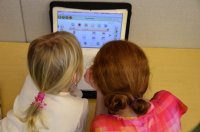Ramping Up Technology for Your Next PBL Project
In my last post about taking PBL projects up a notch, I focused on integration of subject matters and disciplines. Fittingly, this post focuses on integrating technology. Teachers often adjust and improve projects by finding new and innovative ways to infuse technology into the PBL process and products. However, it's not about more technology tools, but about the intentional use of the tools available.
In my classroom, one of the driving forces for reflection in terms of technology integration is the Technology Integration Matrix from the Florida Center for Instructional Technology. The matrix is a great way to focus on how to improve collaboration and knowledge construction by using technology, and also on how to make learning more active and authentic as students work towards specific goals. In fact, I feel this matrix aligns well to PBL and how technology should be used in the PBL classroom (or any classroom). Here are some PBL-specific ways to improve technology integration in the classroom.
Authentic Audience Communication
Teachers often struggle to physically bring authentic audience members into the learning environment. In our day and age of the flat classroom, it only makes sense for students to collaborate with audience members using digital tools. This could be as simple as getting critiqued by sharing a Google document, or having someone Skype in the classroom. One of my favorite projects was having a U.S. solider visit my class virtually to share his experience. This entry event led us into our PBL project that sought to answer, "How do we help soldiers return from war?" Consider using technology to connect with audience members at the beginning middle and/or end of the project.
From Products to Management
Tech and PBL newbies find easy integration with PBL products. Teachers can allow students to show their learning through voice and choice in culminating products. From Prezi to Glogster, these can be great technology tools to create products for PBL that build technology literacy skills. If you want to challenge yourself, consider instead, or in addition, using technology to manage the process of the PBL project. Teachers can use tools like Edmodo, Evernote and Wikis that allow students to use technology for storing information and building projects together. In addition, teachers can use the technology to push out important files or information. Technology can also be used to set goals and reflect throughout the project. Here the technology is infused to help build active learning for students as they work on their PBL project, rather than simply in the creation of culminating products.
Technology to Assess Collaboration
Related to the tip above, teachers can use technology not only to collaborate, but also as tool to assess that critical 21st century skill, collaboration. One part of assessment is documentation, both formative and summative. As students collaborate digitally, a teacher has specific documentation of how students are doing. Have students reflect, and give them specific feedback on how they can improve. Praise them for excellent digital citizenship, and have them share their best examples of digital collaboration. A Twitter or TitanPad chat, for example, can be a great assessment of collaboration.
Technology Literacy as a 21st Century Skill
Although 21st century skills don’t necessarily equal technology, technology literacy can be leveraged as an important 21st century skill to teach and assess. Use quality indicators from the ISTE NETS as well as other rubrics to have students reflect and set goals for their work in effective use of technology. Assess technology literacy either solo or in conjunction with another 21st century skill like collaboration.
If you are looking to grow as a PBL teacher, consider technology as a way to improve not only your PBL projects, but your overall technology integration skills as well. It will be purposeful and intentional!
